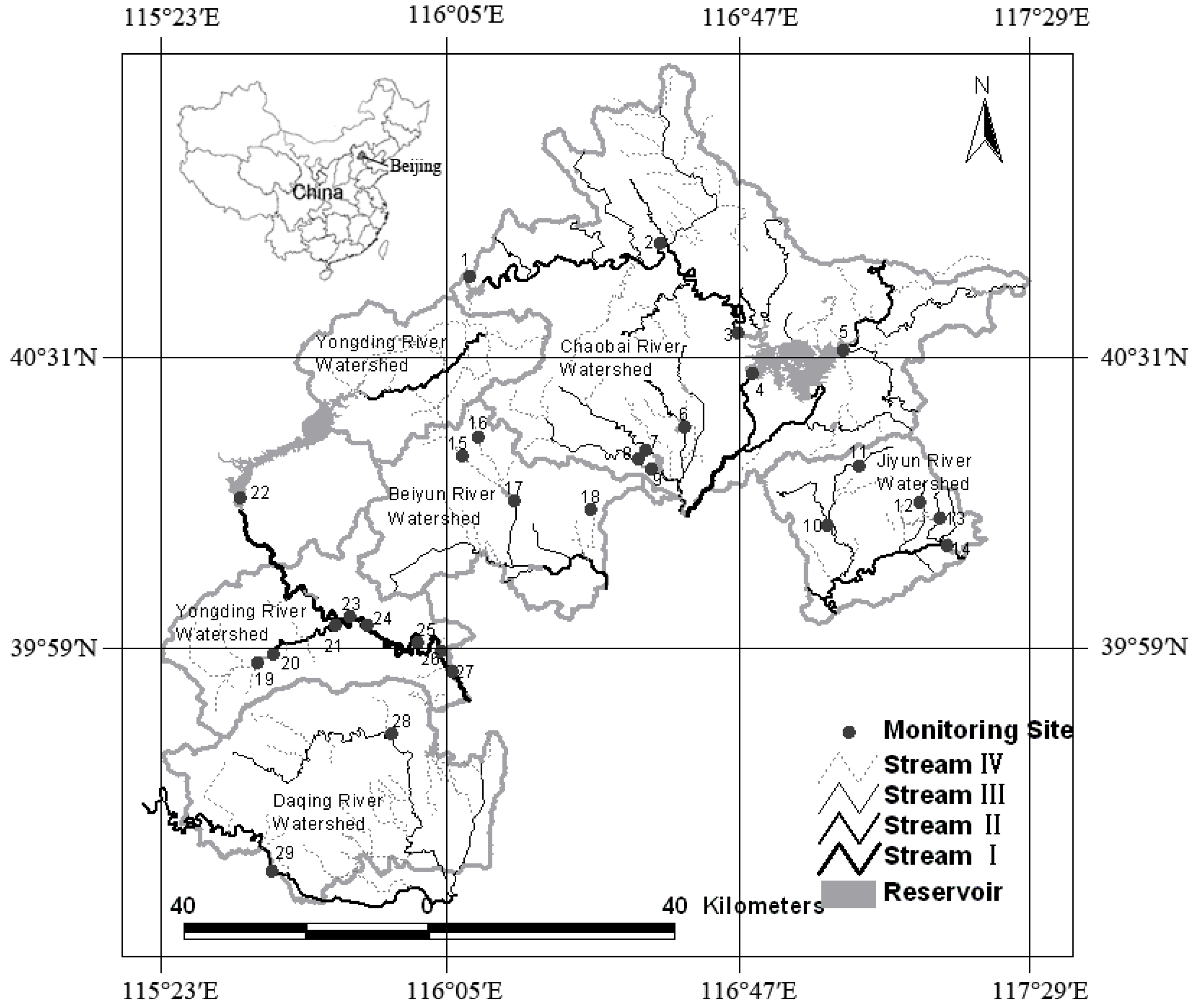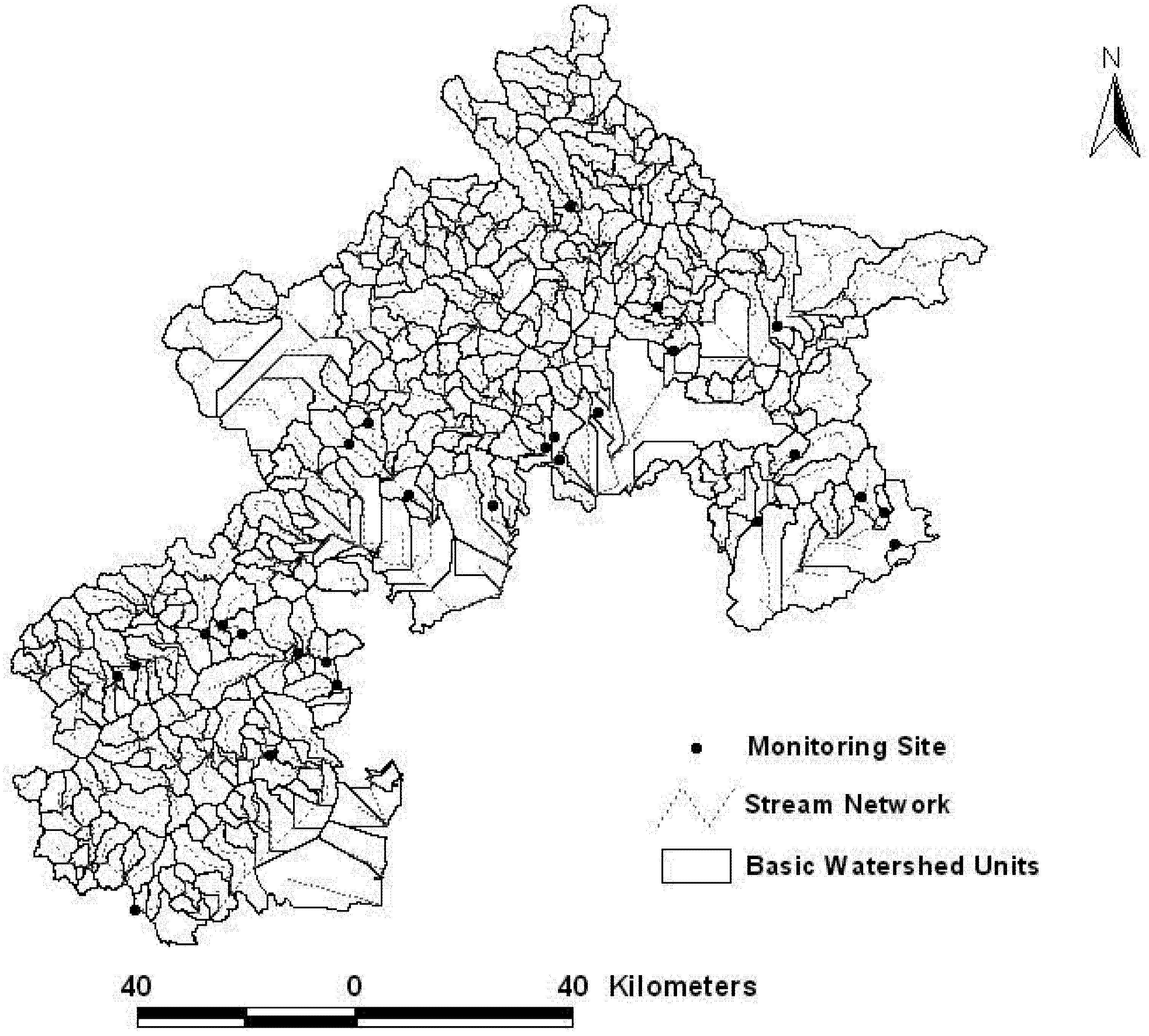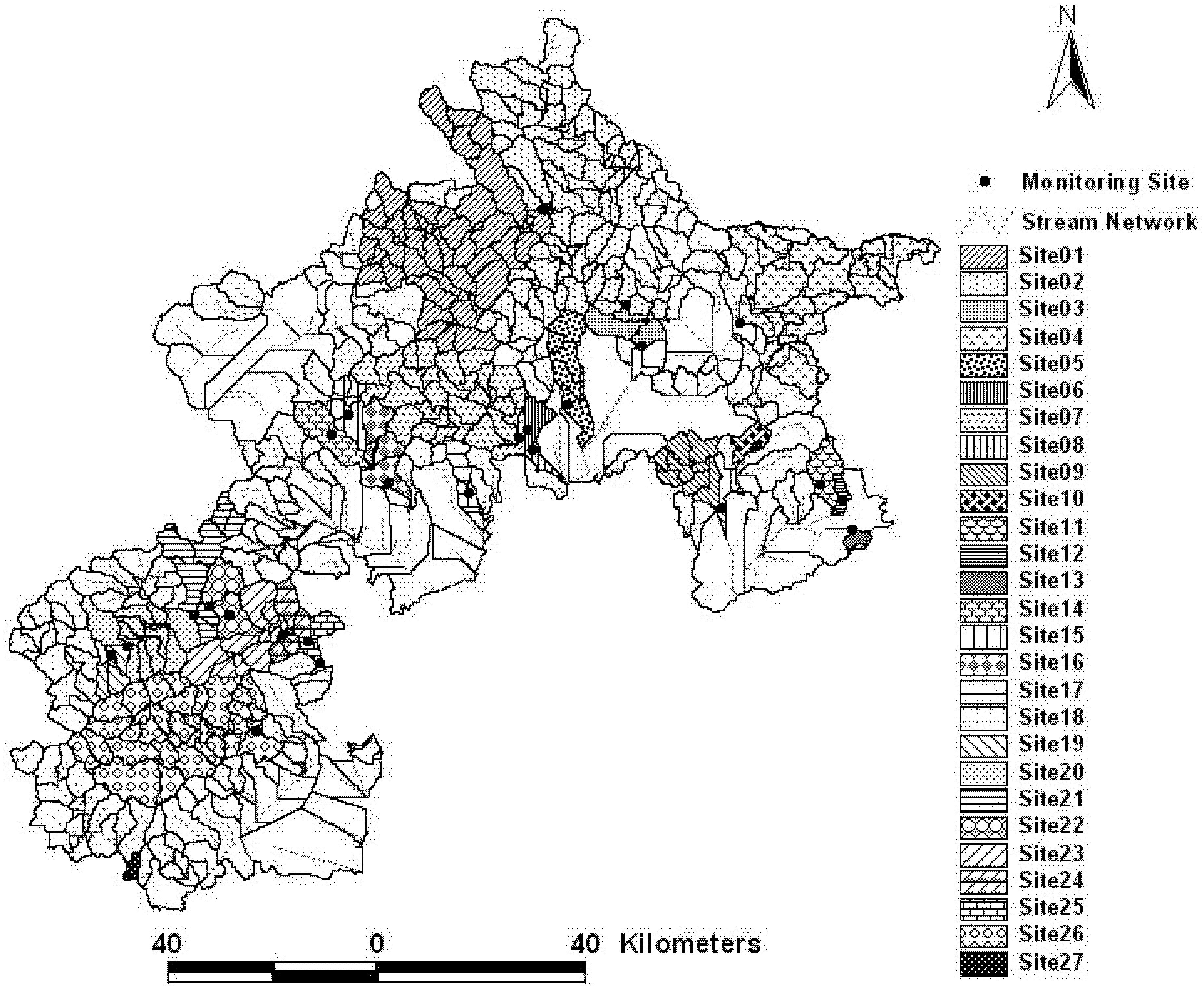1. Introduction
Land use intensity is one of the most significant forms of land cover modification, and can have a major detrimental impact on terrestrial and aquatic ecosystems [
1,
2], and also directly influence human and ecosystem health. Many developed countries are experiencing environmental pollution due to intensive agricultural activities, including intensive crop and livestock production [
3]. This is also the true for the fast developing countries, such as China. From a land use perspective, intensive agricultural activities have been identified as the major sources of non-point source pollutants and are known to alter and impact the quality of the receiving water bodies. As an environmental factors that relate directly to human health, water quality is always subject to degradation when agricultural land use intensity is too high [
4]. Thus, understanding the effects of intensive agricultural land use activities on water resources is essential for natural resource management and environmental improvement. However, these effects on water quality conditions are difficult to determine because of the complex relationships between agricultural land use activities and water quality.
In previous studies water quality was generally linked to land use inside the catchments area. Several studies have found that land use has a strong influence on the receiving water body quality [
5,
6,
7]. The majority of studies about the effects of land use on water quality have focused on either deterministic modeling, or spatial, or statistical analyses. Examples of modeling studies include those performed by Tong and Chen [
5], Chaplot
et al. [
8], Cao
et al. [
9], Bhattarai
et al. [
10],
etc. which have adopted the existing watershed-scale hydrological variables and nonpoint-source pollution models to evaluate or predict how land use/land cover scenarios affect water quality. Since modeling methods need long-term water quality monitoring data and regional parameters are difficult to obtain, current modeling methods are still developmental and confined to mechanism studies in local watersheds. Consequently, there are more studies that have adopted statistical methods such as correlation analysis [
11,
12], single linear regression analysis [
13,
14], multiple linear regression analysis [
15,
16,
17], nonparametric statistical analysis techniques [
18],
etc. to examine the relationships between watershed land use/land cover and water quality.
Since no statistical significant relationships between land uses and nitrate level were found when using the whole basins, contributing areas inside buffer zones were developed by Basnyat
et al [
19]. There have been more subsequent studies taking buffer zones as analysis units to explore water quality characteristics and their relationships [
20,
21,
22]. The definition of contributing zone may open additional ways of visualizing the problem. The previous studies have demonstrated that the contributing zone is influenced by many factors, including the water-quality parameter being assessed and geomorphic/climatic setting of the watershed [
19]. To some extent, buffer zones with multi-scale characteristics, created using the distance from the stream, are not true hydrological units, and they are difficult to delineate and explain the hydrological and ecological condition of the stream validly. To overcome this, our study defines the multi-scale nested watersheds based on the basic watershed units created by a digital elevation model for the purpose of more effective watershed management, and multi-scale analysis is adopted to explore the relationships between agricultural land use intensity and water quality, and further to identify watershed adaptive response units for every water quality parameter.
Beijing’s mountainous watersheds, providing 69.9% of its surface water resources, have played increasingly important roles in drinking water supply and headwater conservation considering the population increase and urban sprawl of Beijing. Moreover, land use changes in the Beijing mountainous areas have brought about many land related problems, such as water pollution, soil contamination and air pollution [
23]. We had adopted emergy analysis with principal component analysis, regression analysis and cluster classification to investigate the characteristics and patterns of agricultural land use intensity of study areas in 2000, as the baseline of ecological monitoring and assessment [
24]. However, the effects of the agricultural land use intensity on surface water quality have not been discussed. Therefore, the objective of this study, taking the Beijing mountainous area as a case, was to investigate the impacts of agricultural land use intensity on selected physical properties of surface water quality using multi-scale analysis for building a baseline database applicable to long-term monitoring.
4. Discussion and Conclusions
4.2. Watershed Adaptive Response Unit
The significant scales at which there were statistically significant relationships between agricultural land use intensity and each water quality variable were identified on the basis of the multi-scale regression analysis, which were considered as the watershed adaptive response units for each water quality variable. Thus, the first order watershed (Zone 1) of 27 monitoring points was the adaptive response unit for nitrate-nitrogen, while the fifth order watershed (Zone 5) was the adaptive response unit for the permanganate index.
In the Beijing mountainous study area, watershed adaptive response units differ with the water quality variables being assessed, which are related with transformation regularity of nitrate-nitrogen and permanganate index. After the use of nitrate fertilizer that is the source of nitrate-nitrogen on agricultural fields, nitrate-nitrogen formed by nitrification is either absorbed and utilized by plants or transformed into gaseous nitrogen through denitrification under reducing conditions. Therefore, only the agricultural inputs inside the first order watershed zones can make a significant contribution to the concentration of nitrate-nitrogen at the pour-point, while that inside other order watershed zones has little influence on the nitrate-nitrogen level at the pour-point with the action of long distance transport.
Compared to nitrate-nitrogen, permanganate index contamination is relatively steady. As the main source, the transformation time of agricultural plastic mulch and pesticides is relatively long. It could not make a significant contribution to the concentration of permanganate index until it accumulates. Therefore, the smaller area basins, such as first order watershed to the fourth order watershed, hardly respond to permanganate index as a contributing zone.
The definition of watershed adaptive response unit based on the basic watershed units, actually a contributing zone, is very meaningful for the purpose of more effective watershed management. It is important to address the fine-scale management issues relate to watershed adaptive response units for every water quality parameter. The adjustment of agricultural input structure and intensity may be carried out inside the individual watershed adaptive response units.
4.3. Modeling
The multiple linear regression model performed using log transformed dependent variables, which was adopted in many previous studies to explore the relationship between land use and stream water, can also provide insight into the linkages between agricultural land use intensity and stream water quality at multiple watershed scales. The statistical models in this study are valuable in examining the relative sensitivity of water quality indexes to alterations in agricultural land use intensity inside the various contributing zones when coupled with expert knowledge. The modeling results can also further help to identify the cause-and-effect relationships between agricultural input intensity and stream water quality inside the watershed adaptive response units, which are important in the management of water quality. The modeling, although statistically significant, showed the relatively weak coefficients of determination. It may be that the spatial incompatibility between the watershed spatial unit and the municipal/town unit was actually existed, or that other potential factors influencing stream water quality variable were not included in the analysis. All of these are worthy of further research.
Although multiple linear regression models are an effective approach for identifying significant agricultural input intensity affecting water quality and explaining the relationship between agricultural land use intensity and stream water quality, they do not appear to quantitatively estimate contribution of respective agricultural land use intensity on the water quality because they are only based on the existence of statistical significance in the analysis data, rather than any mechanistic relationships between sources and receptors. Our future research will focus on understanding the exact mechanisms of the effect of agricultural land use intensity on stream water quality by adopting an alternative “sources-receptors model” based on the mass balance approach.













